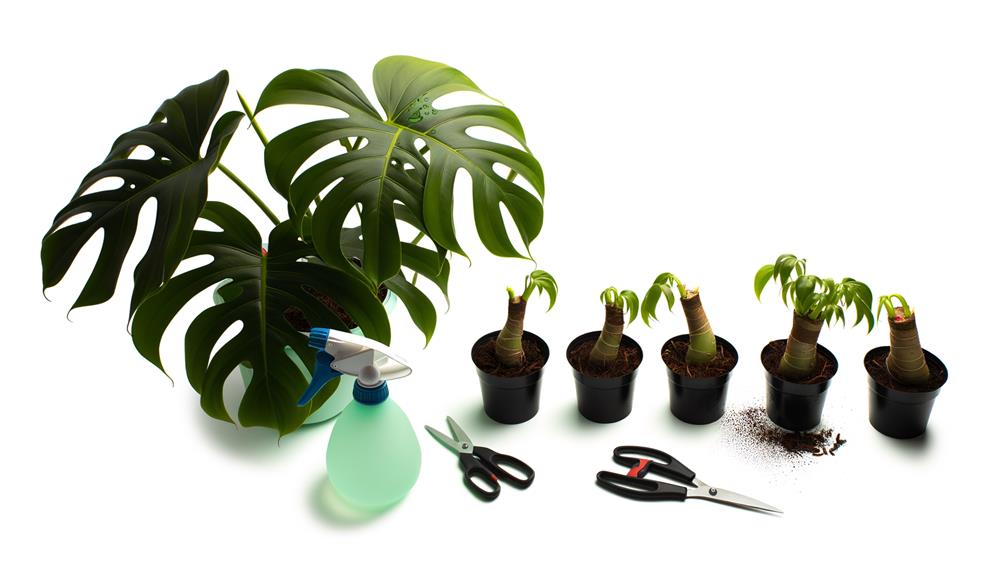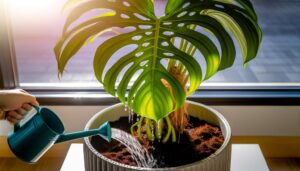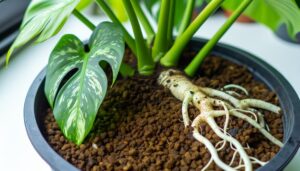Monstera Peru Propagation Success Rate
You can achieve a high propagation success rate for Monstera Peru by using stem cuttings featuring at least one node and aerial root. The nodes contain meristematic cells that can turn into roots and shoots, enhanced by the aerial root's efficiency in water and nutrient uptake.
It's essential to maintain high moisture levels, moderate indirect light, and confirm cuttings are from healthy mother plants. Propagate in spring or early summer to benefit from a 30% higher rooting success.
Sterilize tools to prevent pathogen transmission. Monitoring for overwatering and proper humidity (60-80%) will further increase success.
Learn more about optimizing your propagation process.

Key Takeaways
- Stem cuttings with nodes and aerial roots boost Monstera Peru propagation success.
- Highest success rates occur in spring and early summer with 30% better rooting.
- Ideal conditions include 70-85°F temperatures and 60-80% humidity.
- Overwatering and direct sunlight significantly reduce propagation success.
- Regular monitoring of roots and leaves helps maintain plant health and growth.
Best Propagation Methods
To achieve the highest success rate in propagating Monstera Peru, utilize stem cuttings and make sure they've at least one node and aerial root. This method leverages the plant's natural growth mechanisms. Research confirms that nodes contain meristematic cells capable of differentiating into roots and shoots. The presence of an aerial root notably enhances water and nutrient uptake during the initial rooting phase, promoting faster establishment.
Guarantee the cutting is taken from a healthy mother plant, as poor parent health can impede propagation success. Use sterilized tools to prevent pathogen transmission. After cutting, place the stem in water or a well-draining substrate. Empirical evidence indicates that consistent humidity and moderate indirect light further boost rooting success.
Ideal Growing Conditions
Maintaining optimal growth for Monstera Peru involves upholding a consistent environment with high moisture levels, moderate indirect light, and well-draining soil. Aim for humidity above 60%, as lower levels can impede leaf development.
Place your plant in bright, indirect light; direct sunlight can scorch the leaves, while too little light can slow growth. Choosing the right soil is essential—use a mix that includes perlite or orchid bark to guarantee excellent drainage. Avoid waterlogging, which results in root rot.
Regularly check soil moisture; it should be slightly damp but not soggy. Temperature regulation is equally significant; maintain a range between 65°F and 85°F. Adhering to these evidence-based conditions will optimize your Monstera Peru's health and propagation success.
Timing and Seasonality
Understanding the ideal growing conditions sets the stage for discussing the best timing and seasonality for propagating Monstera Peru.
Propagation success rates peak during the spring and early summer months. During this period, increased daylight and warmer temperatures stimulate active growth. Aim to propagate when ambient temperatures consistently range between 70-85°F (21-29°C).
Avoid winter propagation; reduced light and cooler temperatures can hinder root development. Empirical evidence indicates that cuttings taken in spring exhibit a 30% higher rooting success rate compared to those taken in autumn.
Additionally, make sure humidity levels remain between 60-80%. Employing these timing strategies, supported by controlled studies, enhances your chances of achieving robust root systems and overall plant health.
Common Propagation Mistakes
Overwatering the cuttings is one of the most common mistakes, often leading to root rot and reducing propagation success rates. When cuttings sit in excessively moist environments, oxygen availability to the developing roots decreases, causing anaerobic conditions that promote pathogenic bacteria and fungi.
You should also avoid placing cuttings in direct sunlight. Excessive light increases transpiration rates, leading to dehydration. Additionally, using dull or contaminated tools can introduce pathogens, compromising the cutting's health. Make sure you're using sterilized, sharp instruments for clean cuts.
Monitoring Growth and Health
Regularly examining your Monstera Peru cuttings for signs of growth and potential issues is crucial for maintaining their health and promoting successful propagation. Check the roots bi-weekly for signs of rot, which can be indicated by brown, mushy textures.
Observe leaf color; chlorosis (yellowing) may indicate nutrient deficiencies or improper light exposure. Measure new growth rates; healthy cuttings typically show visible progress within 4-6 weeks.
Guarantee that humidity levels remain between 60-80%, as Monstera Peru thrives in high humidity. Also, monitor for pests like spider mites and aphids, which can impede growth.
Utilize a balanced, water-soluble fertilizer monthly to support nutrient uptake. Consistent monitoring enables you to address issues promptly, enhancing the overall success rate of your propagation efforts.
Conclusion
By following the best propagation methods and ensuring ideal growing conditions, you'll boost your Monstera Peru propagation success rate significantly. Timing and seasonality play pivotal roles, so avoid common mistakes like overwatering or inadequate light.
Monitoring growth and health with precision will maximize your success. Evidence shows that adhering to these guidelines yields consistent results, proving that meticulous care leads to thriving Monstera Peru cuttings.
So, engage with confidence and watch your plants flourish.






